Comprehensive Summary: War and the People by Charles Townshend
VerifiedAdded on 2022/08/08
|5
|1142
|15
Essay
AI Summary
This essay provides a summary of Charles Townshend's 'War and the People,' focusing on the profound impact of world wars on European society. It highlights the unprecedented mobilization of human and material resources, the shifts in economic structures, and the redefinition of gender roles during wartime. The essay also discusses the evolving role of the state in managing wartime economies, the rise of labor movements, and the implementation of welfare policies. Furthermore, it explores the ideological polarization caused by the wars and the uneven distribution of suffering, with the Holocaust standing as a particularly horrific example. The essay concludes by emphasizing the importance of understanding post-war society in the context of its wartime experiences.
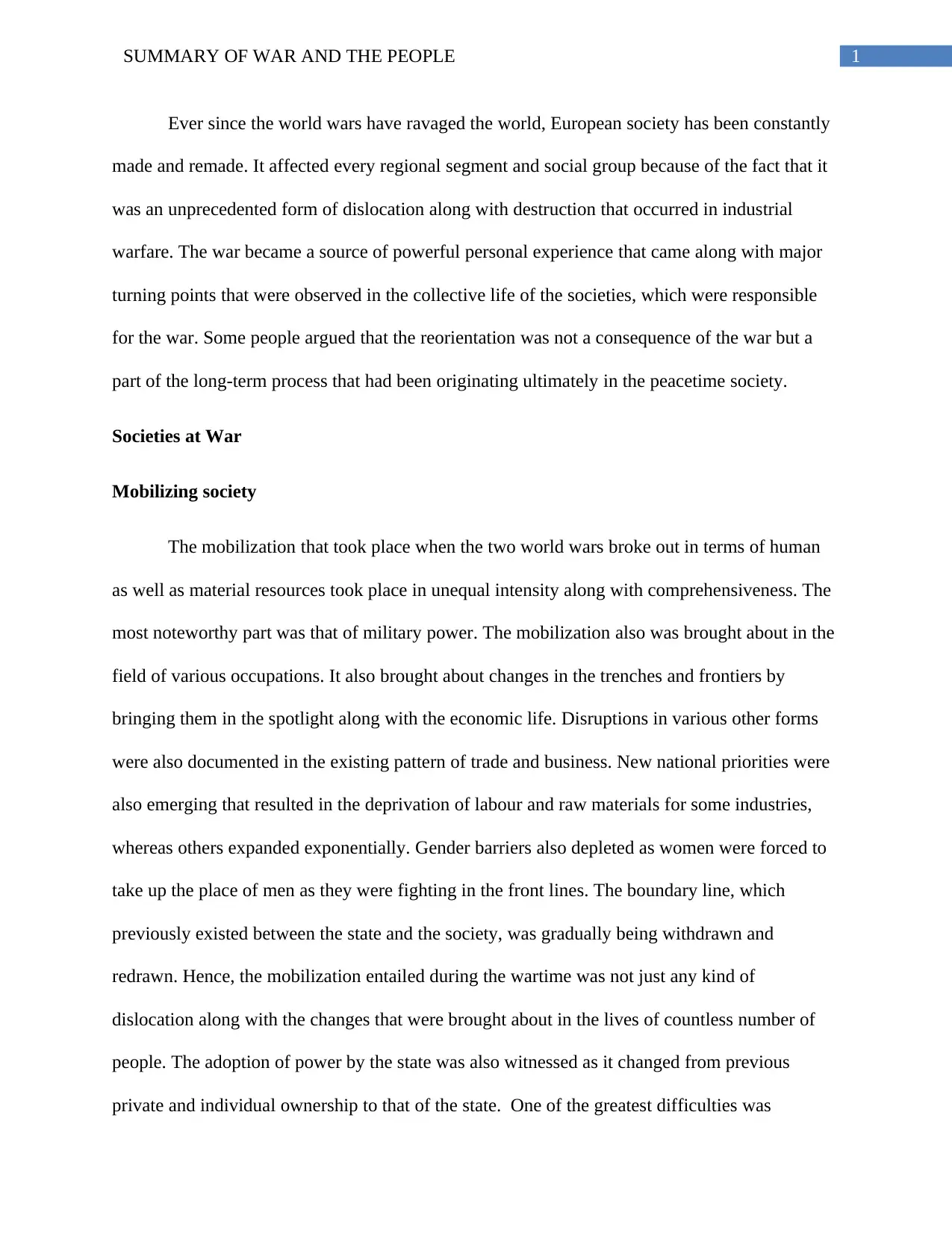
1SUMMARY OF WAR AND THE PEOPLE
Ever since the world wars have ravaged the world, European society has been constantly
made and remade. It affected every regional segment and social group because of the fact that it
was an unprecedented form of dislocation along with destruction that occurred in industrial
warfare. The war became a source of powerful personal experience that came along with major
turning points that were observed in the collective life of the societies, which were responsible
for the war. Some people argued that the reorientation was not a consequence of the war but a
part of the long-term process that had been originating ultimately in the peacetime society.
Societies at War
Mobilizing society
The mobilization that took place when the two world wars broke out in terms of human
as well as material resources took place in unequal intensity along with comprehensiveness. The
most noteworthy part was that of military power. The mobilization also was brought about in the
field of various occupations. It also brought about changes in the trenches and frontiers by
bringing them in the spotlight along with the economic life. Disruptions in various other forms
were also documented in the existing pattern of trade and business. New national priorities were
also emerging that resulted in the deprivation of labour and raw materials for some industries,
whereas others expanded exponentially. Gender barriers also depleted as women were forced to
take up the place of men as they were fighting in the front lines. The boundary line, which
previously existed between the state and the society, was gradually being withdrawn and
redrawn. Hence, the mobilization entailed during the wartime was not just any kind of
dislocation along with the changes that were brought about in the lives of countless number of
people. The adoption of power by the state was also witnessed as it changed from previous
private and individual ownership to that of the state. One of the greatest difficulties was
Ever since the world wars have ravaged the world, European society has been constantly
made and remade. It affected every regional segment and social group because of the fact that it
was an unprecedented form of dislocation along with destruction that occurred in industrial
warfare. The war became a source of powerful personal experience that came along with major
turning points that were observed in the collective life of the societies, which were responsible
for the war. Some people argued that the reorientation was not a consequence of the war but a
part of the long-term process that had been originating ultimately in the peacetime society.
Societies at War
Mobilizing society
The mobilization that took place when the two world wars broke out in terms of human
as well as material resources took place in unequal intensity along with comprehensiveness. The
most noteworthy part was that of military power. The mobilization also was brought about in the
field of various occupations. It also brought about changes in the trenches and frontiers by
bringing them in the spotlight along with the economic life. Disruptions in various other forms
were also documented in the existing pattern of trade and business. New national priorities were
also emerging that resulted in the deprivation of labour and raw materials for some industries,
whereas others expanded exponentially. Gender barriers also depleted as women were forced to
take up the place of men as they were fighting in the front lines. The boundary line, which
previously existed between the state and the society, was gradually being withdrawn and
redrawn. Hence, the mobilization entailed during the wartime was not just any kind of
dislocation along with the changes that were brought about in the lives of countless number of
people. The adoption of power by the state was also witnessed as it changed from previous
private and individual ownership to that of the state. One of the greatest difficulties was
Paraphrase This Document
Need a fresh take? Get an instant paraphrase of this document with our AI Paraphraser
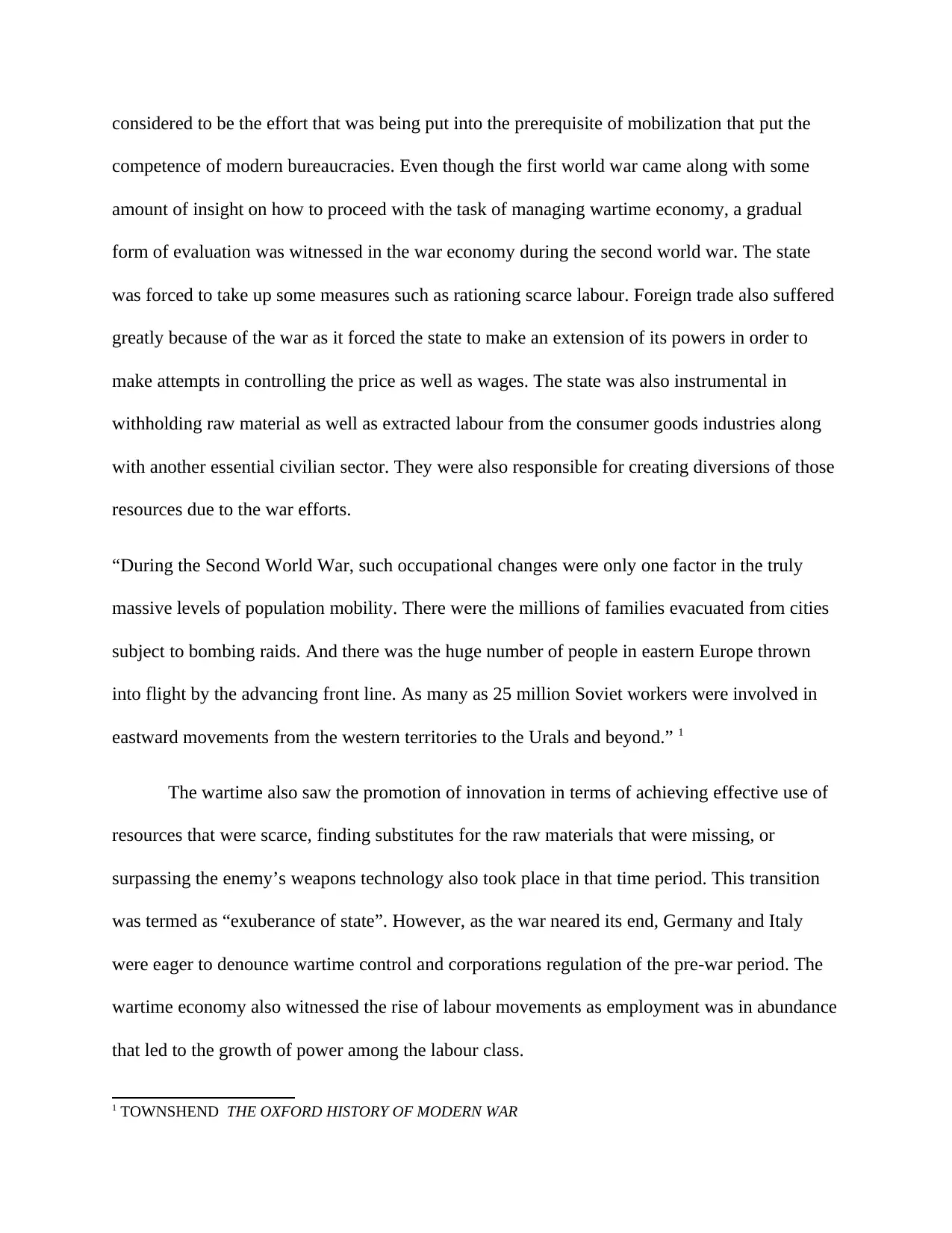
considered to be the effort that was being put into the prerequisite of mobilization that put the
competence of modern bureaucracies. Even though the first world war came along with some
amount of insight on how to proceed with the task of managing wartime economy, a gradual
form of evaluation was witnessed in the war economy during the second world war. The state
was forced to take up some measures such as rationing scarce labour. Foreign trade also suffered
greatly because of the war as it forced the state to make an extension of its powers in order to
make attempts in controlling the price as well as wages. The state was also instrumental in
withholding raw material as well as extracted labour from the consumer goods industries along
with another essential civilian sector. They were also responsible for creating diversions of those
resources due to the war efforts.
“During the Second World War, such occupational changes were only one factor in the truly
massive levels of population mobility. There were the millions of families evacuated from cities
subject to bombing raids. And there was the huge number of people in eastern Europe thrown
into flight by the advancing front line. As many as 25 million Soviet workers were involved in
eastward movements from the western territories to the Urals and beyond.” 1
The wartime also saw the promotion of innovation in terms of achieving effective use of
resources that were scarce, finding substitutes for the raw materials that were missing, or
surpassing the enemy’s weapons technology also took place in that time period. This transition
was termed as “exuberance of state”. However, as the war neared its end, Germany and Italy
were eager to denounce wartime control and corporations regulation of the pre-war period. The
wartime economy also witnessed the rise of labour movements as employment was in abundance
that led to the growth of power among the labour class.
1 TOWNSHEND THE OXFORD HISTORY OF MODERN WAR
competence of modern bureaucracies. Even though the first world war came along with some
amount of insight on how to proceed with the task of managing wartime economy, a gradual
form of evaluation was witnessed in the war economy during the second world war. The state
was forced to take up some measures such as rationing scarce labour. Foreign trade also suffered
greatly because of the war as it forced the state to make an extension of its powers in order to
make attempts in controlling the price as well as wages. The state was also instrumental in
withholding raw material as well as extracted labour from the consumer goods industries along
with another essential civilian sector. They were also responsible for creating diversions of those
resources due to the war efforts.
“During the Second World War, such occupational changes were only one factor in the truly
massive levels of population mobility. There were the millions of families evacuated from cities
subject to bombing raids. And there was the huge number of people in eastern Europe thrown
into flight by the advancing front line. As many as 25 million Soviet workers were involved in
eastward movements from the western territories to the Urals and beyond.” 1
The wartime also saw the promotion of innovation in terms of achieving effective use of
resources that were scarce, finding substitutes for the raw materials that were missing, or
surpassing the enemy’s weapons technology also took place in that time period. This transition
was termed as “exuberance of state”. However, as the war neared its end, Germany and Italy
were eager to denounce wartime control and corporations regulation of the pre-war period. The
wartime economy also witnessed the rise of labour movements as employment was in abundance
that led to the growth of power among the labour class.
1 TOWNSHEND THE OXFORD HISTORY OF MODERN WAR
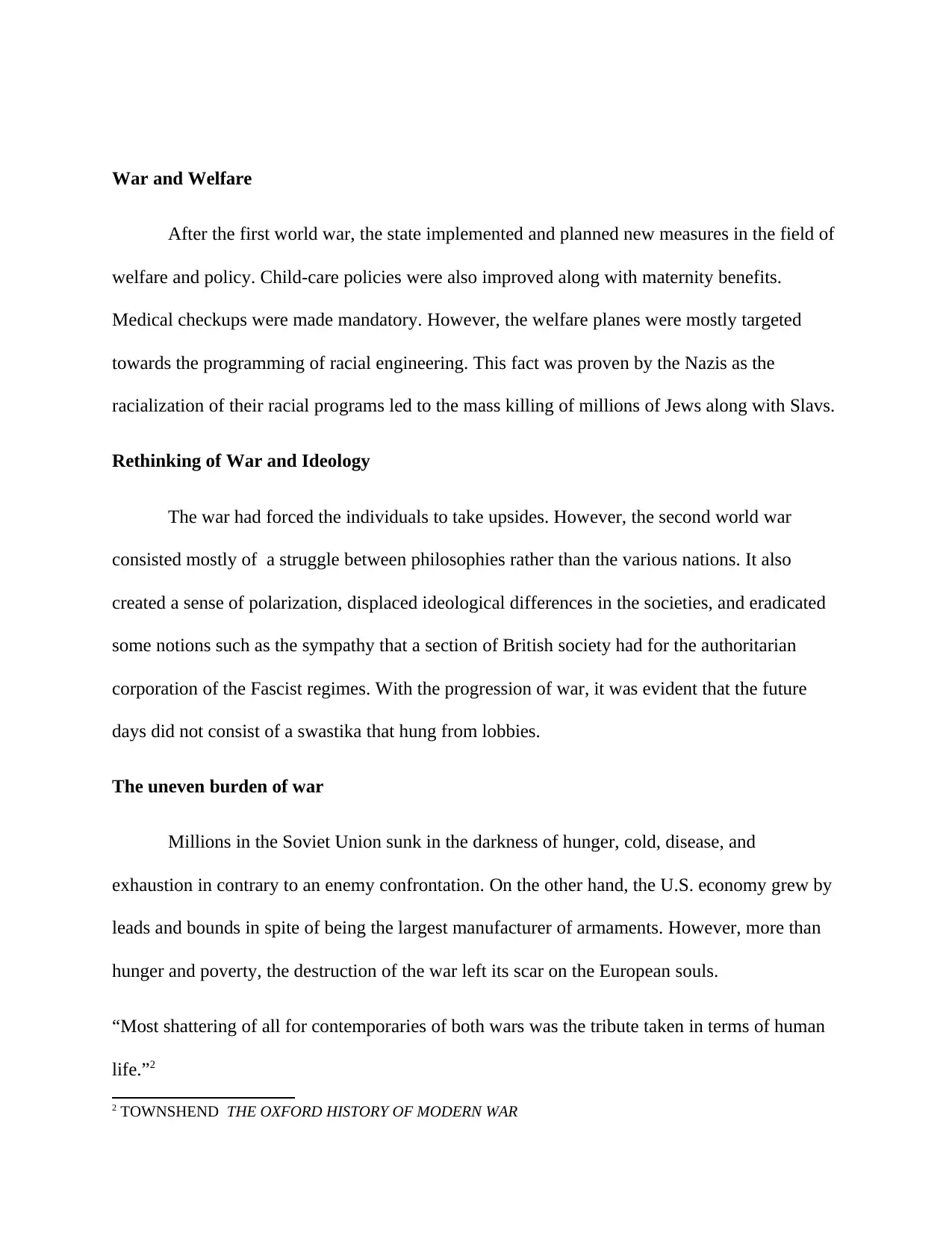
War and Welfare
After the first world war, the state implemented and planned new measures in the field of
welfare and policy. Child-care policies were also improved along with maternity benefits.
Medical checkups were made mandatory. However, the welfare planes were mostly targeted
towards the programming of racial engineering. This fact was proven by the Nazis as the
racialization of their racial programs led to the mass killing of millions of Jews along with Slavs.
Rethinking of War and Ideology
The war had forced the individuals to take upsides. However, the second world war
consisted mostly of a struggle between philosophies rather than the various nations. It also
created a sense of polarization, displaced ideological differences in the societies, and eradicated
some notions such as the sympathy that a section of British society had for the authoritarian
corporation of the Fascist regimes. With the progression of war, it was evident that the future
days did not consist of a swastika that hung from lobbies.
The uneven burden of war
Millions in the Soviet Union sunk in the darkness of hunger, cold, disease, and
exhaustion in contrary to an enemy confrontation. On the other hand, the U.S. economy grew by
leads and bounds in spite of being the largest manufacturer of armaments. However, more than
hunger and poverty, the destruction of the war left its scar on the European souls.
“Most shattering of all for contemporaries of both wars was the tribute taken in terms of human
life.”2
2 TOWNSHEND THE OXFORD HISTORY OF MODERN WAR
After the first world war, the state implemented and planned new measures in the field of
welfare and policy. Child-care policies were also improved along with maternity benefits.
Medical checkups were made mandatory. However, the welfare planes were mostly targeted
towards the programming of racial engineering. This fact was proven by the Nazis as the
racialization of their racial programs led to the mass killing of millions of Jews along with Slavs.
Rethinking of War and Ideology
The war had forced the individuals to take upsides. However, the second world war
consisted mostly of a struggle between philosophies rather than the various nations. It also
created a sense of polarization, displaced ideological differences in the societies, and eradicated
some notions such as the sympathy that a section of British society had for the authoritarian
corporation of the Fascist regimes. With the progression of war, it was evident that the future
days did not consist of a swastika that hung from lobbies.
The uneven burden of war
Millions in the Soviet Union sunk in the darkness of hunger, cold, disease, and
exhaustion in contrary to an enemy confrontation. On the other hand, the U.S. economy grew by
leads and bounds in spite of being the largest manufacturer of armaments. However, more than
hunger and poverty, the destruction of the war left its scar on the European souls.
“Most shattering of all for contemporaries of both wars was the tribute taken in terms of human
life.”2
2 TOWNSHEND THE OXFORD HISTORY OF MODERN WAR
⊘ This is a preview!⊘
Do you want full access?
Subscribe today to unlock all pages.

Trusted by 1+ million students worldwide
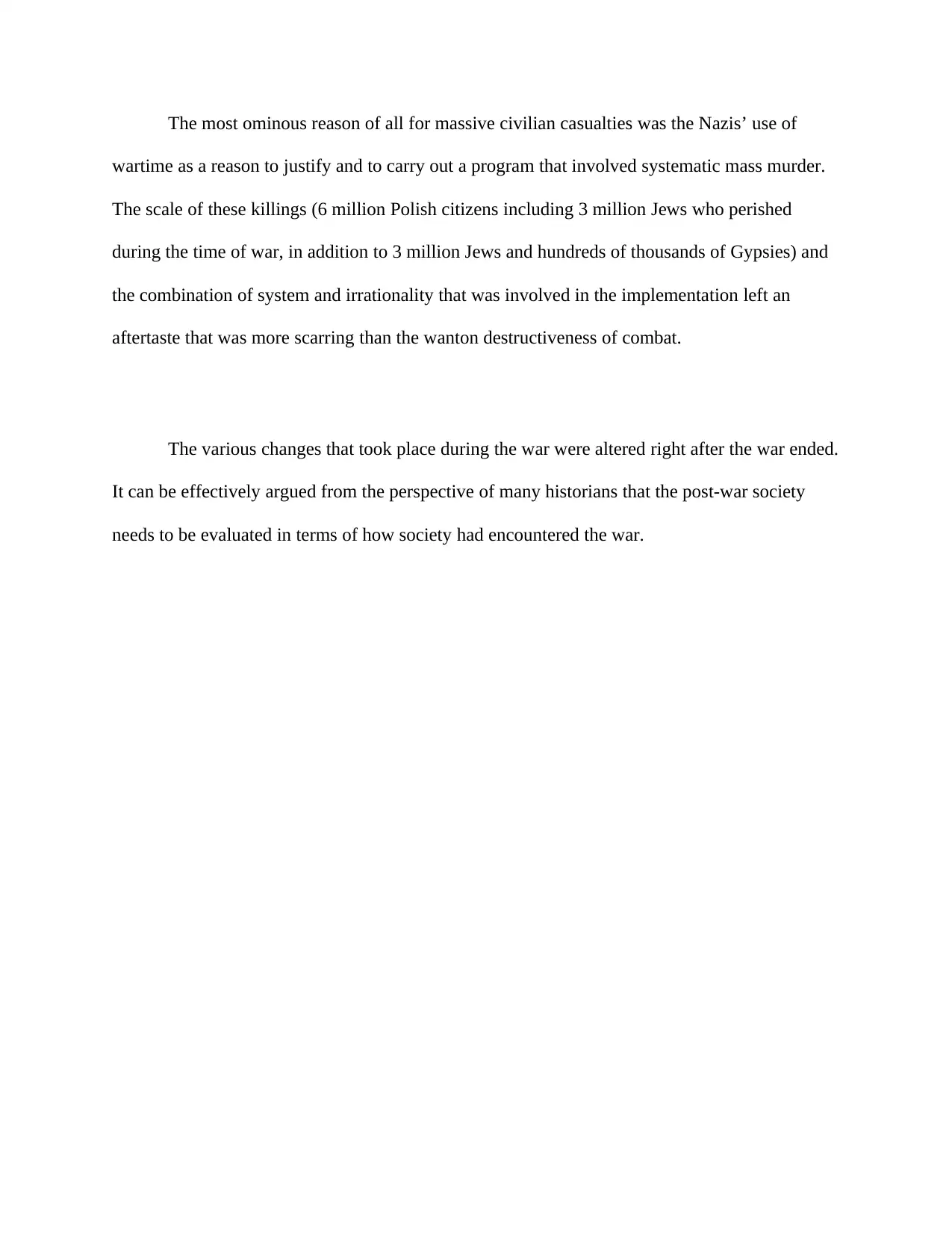
The most ominous reason of all for massive civilian casualties was the Nazis’ use of
wartime as a reason to justify and to carry out a program that involved systematic mass murder.
The scale of these killings (6 million Polish citizens including 3 million Jews who perished
during the time of war, in addition to 3 million Jews and hundreds of thousands of Gypsies) and
the combination of system and irrationality that was involved in the implementation left an
aftertaste that was more scarring than the wanton destructiveness of combat.
The various changes that took place during the war were altered right after the war ended.
It can be effectively argued from the perspective of many historians that the post-war society
needs to be evaluated in terms of how society had encountered the war.
wartime as a reason to justify and to carry out a program that involved systematic mass murder.
The scale of these killings (6 million Polish citizens including 3 million Jews who perished
during the time of war, in addition to 3 million Jews and hundreds of thousands of Gypsies) and
the combination of system and irrationality that was involved in the implementation left an
aftertaste that was more scarring than the wanton destructiveness of combat.
The various changes that took place during the war were altered right after the war ended.
It can be effectively argued from the perspective of many historians that the post-war society
needs to be evaluated in terms of how society had encountered the war.
Paraphrase This Document
Need a fresh take? Get an instant paraphrase of this document with our AI Paraphraser
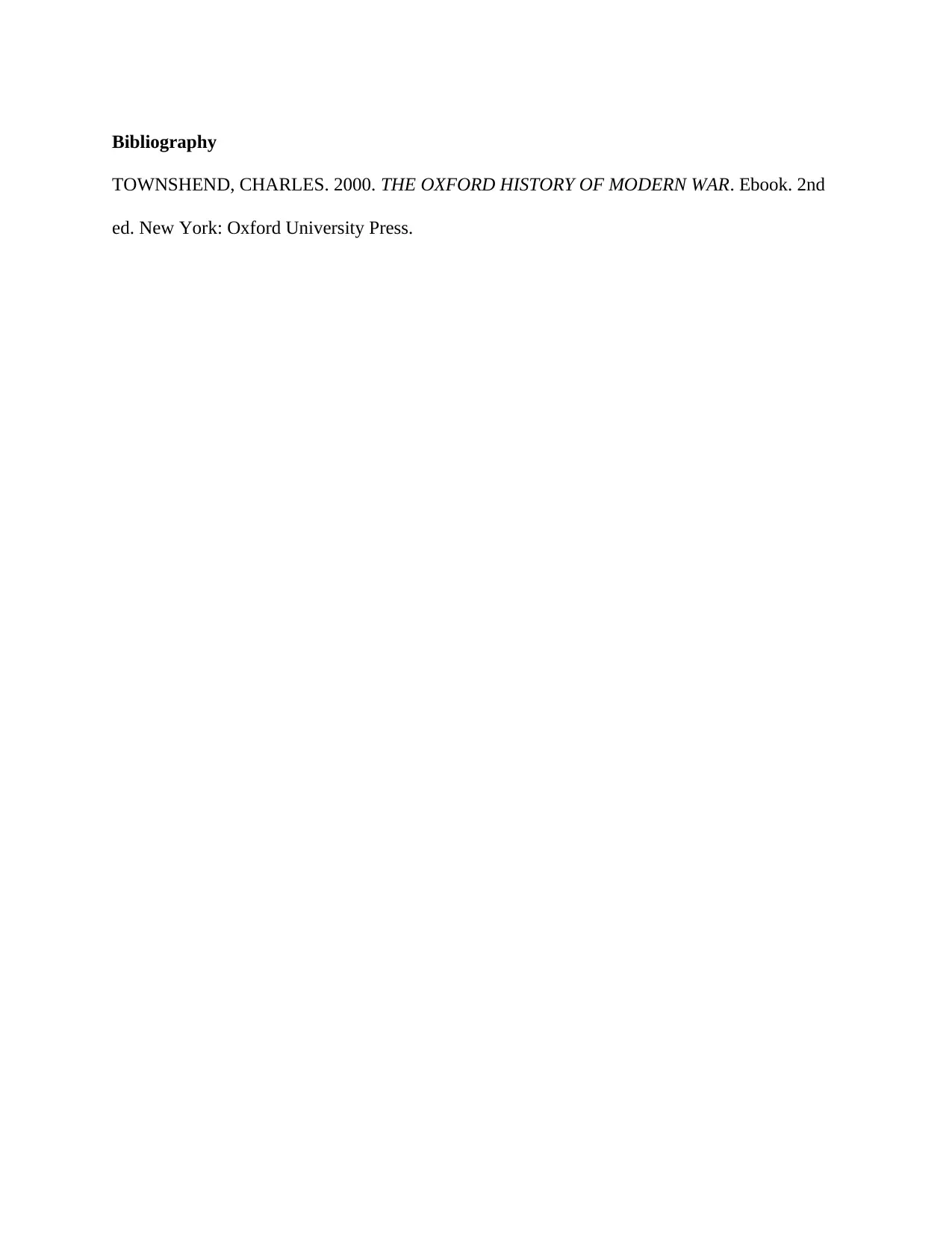
Bibliography
TOWNSHEND, CHARLES. 2000. THE OXFORD HISTORY OF MODERN WAR. Ebook. 2nd
ed. New York: Oxford University Press.
TOWNSHEND, CHARLES. 2000. THE OXFORD HISTORY OF MODERN WAR. Ebook. 2nd
ed. New York: Oxford University Press.
1 out of 5
Related Documents
Your All-in-One AI-Powered Toolkit for Academic Success.
+13062052269
info@desklib.com
Available 24*7 on WhatsApp / Email
![[object Object]](/_next/static/media/star-bottom.7253800d.svg)
Unlock your academic potential
Copyright © 2020–2025 A2Z Services. All Rights Reserved. Developed and managed by ZUCOL.





